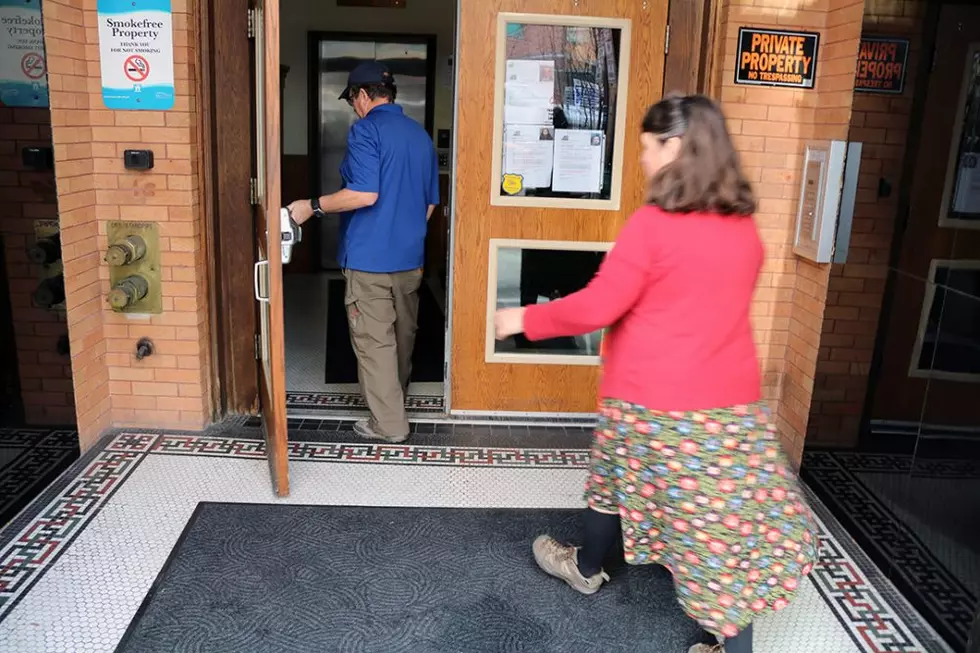
From lavish hotel to affordable housing, the historic Palace still serves Missoula
An old matchbook dating back to the heyday of the Palace Hotel in downtown Missoula tempted guests with 150 “modern rooms.” Back around 1940, those rooms would have provided a substantial view of a small but thriving city.
Nearly eight decades later, as the building's maintenance technician navigates the maze of hallways, Dana Nichols counts less than 80 doors, and some of those doors no longer access a room.
“We have 60 units and we have some false doors in the hallway,” said Nichols. “They're not real rooms. I counted all of the false doors and all the real doors, and I only counted 80-something doors.”
Mysteries aside, the downtown Palace now serves as one of the largest single structures dedicated to affordable housing in Missoula.
Its array of rooms, now a collection of self-sustaining apartments, serves a niche in a city that, like so many others, is struggling to provide housing to those at the bottom of the income bracket.
At the Palace, costs are tied to a pricing structure set by the state.
“It's tied to a maximum amount of area median income,” said Elizabeth Marshall, the building's property manager. “We have caps as our way of making sure this really nice housing only brings in folks at lower income levels.”
Today's occupants range from the elderly to families with infants, as well as young up-and-comers starting a career. For most of the units, a household of one must earn less than $25,700 to qualify for an apartment.
But pricing in tax-credit housing is “complicated,” Marshall noted, and room prices vary. In general, studios rent for $540, one-bedrooms for $590 and two bedrooms for $650. Some units may rent for less to those with a minimal income.
“I pretty much lease out to unhoused folks here,” said Marshall. “We turn over 10 to 12 apartments a year, generally. Last year, I only had two people come in who previously had a roof over their head.”
Unlike private property managers, the Missoula Housing Authority has more flexibility in working with tenants, including those who lack references or a rental history due to periods of homelessness.
A landlord reference, for example, could come from the Poverello, where tenants are required to fulfill certain chores and be a good neighbor. If they did their part and followed the rules, it could serve as a glowing reference.
“We're able to have a broader net,” Marshall said. “We can generally house different folks than other property managers can. We just have more flexibility.”
But the property still requires an application fee, and it still runs a criminal and credit report, though Marshall said the latter doesn't weigh too heavily on the final outcome.
As a tax-credit property, rents must pay for salaries, maintenance and reserve accounts. In other words, Marshall said, they have to fund the building in cash flow, and those costs are covered by the rent structure.
“Yes, we're the housing authority and we have a mission to create stable housing for folks in our community, but we're also a business with a bottom line,” Marshall said. “When we're screening folks, we have to consider risk assessment. Everyone deserves a home, but we can't house everybody.”
The housing authority purchased the Palace in 2002 with the purpose of making it affordable. The agency applied for Low Income Housing Tax Credits in 2012 and started renovations in 2013.
The tax credits were provided by an investor in Chicago who paid a portion of the building's $9 million renovations. The Missoula Housing Authority serves as the owner and reports to the Montana Board of Housing.
It would cost tens of millions of dollars to build a similar structure on a similar downtown lot, a fact that pushes many new projects beyond the reach of “affordable housing.”
“It's great housing for everybody that is income qualified in the heart of downtown,” Marshall said. “I believe the Palace Apartments is a cornerstone in the city's vision to make downtown living a vibrant opportunity.”
The building's history dates back to around 1910 when the original Palace was constructed on the corner of Broadway and Ryman. It doubled in size in 1940.
“A couple of years ago, a gentleman stopped in to say hello,” Marshall said. “His grandfather bought the building in the 1930s. It was a thriving hotel, but it was coming out of its heyday and it probably had seen its glory days.”
The Florence Hotel opened on Higgins Avenue in the 1940s. Not to be outdone, the gentleman's grandfather built a substantial addition to the Palace, also in the art deco style.
From the outside, the Palace still resembles two separate buildings. But on the inside, it's a single structure that doesn't match up perfectly. Some hallways step down where the buildings came together. On some floors, the transition is more drastic.
The upper floors are still served by an old Otis elevator.
“We went up on the elevator and when it opened, it felt like we were in a totally different building,” said Nichols, recalling the renovation years. “It was like Willie Wonka’s elevator took us sideways or something. It was a totally different era. It was rough. There was a lot of maintenance needing done.”
But with the tax credits, the building has regained its former luster, not as a hotel but as affordable housing.
“Deep into the building, things are new,” said Marshall. “The renovation went so deep into the building, they basically went down to the studs on the inside.”
